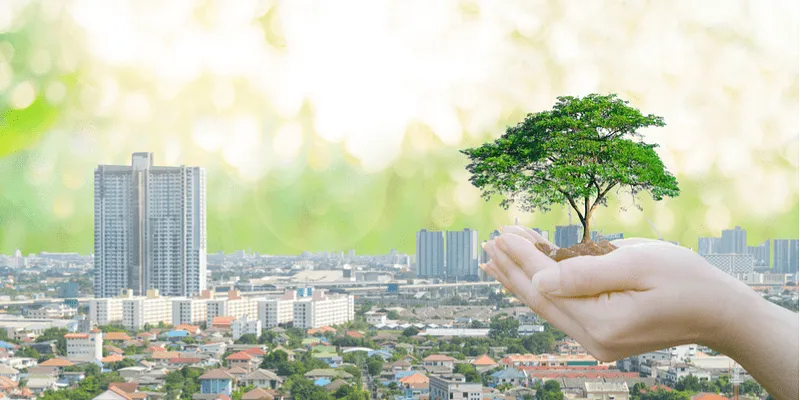The Future of Built Environment in India
The future of the built environment in India lies in adapting to the changing needs of the Indian population and the pedagogy through which students of architecture, design and planning are taught must be maximised to promote an innovative outlook.

The role of infrastructure in an Economy
It is well-known that for a country’s economy to achieve peak productivity, efficient, user-friendly, useful and extensively-placed infrastructure is required. Public infrastructure includes not only structures such as transport links, drainage, energy provision centres etc. but also educational institutions, government offices and recreational spaces such as parks and beaches.
It was found that governments of countries who rank the highest on the Human Development Index (HDI) -- Norway, for example -- spend the largest portion of their tax revenue on public infrastructure and environmental conservation as opposed to industrialisation and military facilities. Since HDI is a measure of the overall quality of life, it is reasonable to conclude that public infrastructure is key to increasing the quality of life in a country.
In light of current events such as the COVID-19, the state of infrastructure in India has become all too clear. Even economically essential cities such as Ahmedabad, Delhi and Mumbai found themselves ill-prepared to deal with the number of infected cases. It is easy enough to blame this on the irresponsibility of citizens or the ineffectiveness of the government, yet the facts do not change. The healthcare infrastructure in place is either old and outdated or unaffordable by the majority of Indians.
Is infrastructure completely rigid, or can it be changed to suit our needs?
Human tendency is to believe that what is, had to be that way. In other words, we have begun to view this as natural. In reality, everything in our surroundings is a certain way since it was made to be that way, and can be changed or unmade just as easily.
This statement is particularly true of our built environment. Cinema houses are relaxing solely because they are designed to be so, hospitals promote a safe, sterile environment, simply because they are designed to do so.
Therefore, it is possible to influence an individual’s perception of a space and its purpose through the design of the space itself.
For instance, it is perfectly plausible that a dark and gloomily designed space will evoke feelings of dread in a visitor.
So far, we have concluded that the role infrastructure plays in our life is to help maintain and increase our living standards, and the role a built environment plays is to shape our perception of a space and its functions.
These very properties of the built environment are an extremely useful asset to the current generation of Indians in the face of the unique problems it faces. Mental health disorders are on the rise with a severe shortage of psychiatry and counselling facilities, domestic violence, sanitation, overpopulation, hunger etc. are some of the numerous other problems we need to overcome, and better designed public health infrastructure may be part of the answer to them.
What inspiration can we take from our peers?
Certain zoning laws in the USA prevent high-density development that occurs due to the unplanned integration of commercial, residential and recreational spaces. These laws stem from interventions used to halt the spread of infectious diseases in the 19th century. This is a principle that urban planners in India may find useful, considering the high population density in large cities and the risk it poses during the outbreak of an infectious disease.
Town planning in India varies greatly across all 28 states, however, it is clear that infectious diseases have not been kept in mind as urban sprawl has been allowed to occur.
The pandemic has proven that the greatest risk from the virus is to people living in high-density, crowded settlements without adequate water supplies and sanitation. Therefore, town planners could use these American zoning laws as a guideline to build cities such that the spread of disease can be halted easily.
The two ways of achieving this are, building lower-density settlements, which will prove difficult with a population as large as ours, the other option is to provide proper healthcare facilities in close proximity to residential areas. This includes, the provision of dispensaries, facilities to check for the outbreak of new diseases, clinics and also psychiatric clinics.
How do we respond through design derivatives?
Now the question that arises is how to build this new infrastructure. The answer is relatively straightforward. In the short term, planners and architects could make use of modular architecture. Converting items such as shipping containers and decommissioned rail engines into isolation wards and treatment facilities will allow the problem to be mitigated somewhat.
In the long term, the solution could focus on constructing infrastructure that promotes a sustainable lifestyle and ensures well-being of people in the environment. All buildings, whether residential, commercial or a public structure, should be resilient and flexible enough to be converted into whatever facility is required during an emergency.
Needless to say, it must be in compliance with government norms and regulations. These state that all such spaces must have a certain amount of space allotted for services, utility and common areas.
Another approach to this problem may involve the use of affordable housing schemes by the government. These will allow us to facilitate people in need of shelter such as street-dwellers, refugees, migrants and other below-poverty-line individuals. These housing premises should be designed such that they can be easily converted into service areas whenever the need arises.
As treatment centres and isolation wards are now available throughout the residential spaces, operating capacity in larger, better equipped hospitals is freed up to accept a larger number of more severe cases. Public buildings such as civic centres, municipal offices, community halls etc. should be designed to provide maximum space usage and incorporate essential services such as sanitation, electricity backups and adequate water supply so that they can be of use during an outbreak.
In addition to the above, transitory spaces should be extensive, well-planned, and connected with each other, considering all movements and activity that may occur. In hospitals, pathways should be designed to maximise connectivity in order to ensure the smooth passage of patients from one point to another.
Care must also be taken to ensure that storage spaces are adequately large and have spare capacity available. During emergencies, interior transformations can be implemented through the use of temporary partitions etc. It is also essential to ensure that only those building materials are used that are easy to sanitise.
Conclusion
The future of the built environment in India lies in adapting to the changing needs of the Indian population. The pedagogy through which students of architecture, design and planning are taught must be maximised to promote an innovative outlook and keep pace with the requirements of the current scenario. Design challenges in studio courses should focus on the resilience and adaptability of the design.
Architects and designers therefore need to readdress the basics, while adding more layers to their teachings. Hence, pushing students to create integrated design solutions.
At present, one of the most pressing concerns is healthcare and sanitation. Therefore it is these that we must turn our sights to and work towards improving, for the good of the nation, its people and the generations to come.
(Edited by Apoorva Puranik)
(Disclaimer: The views and opinions expressed in this article are those of the author and do not necessarily reflect the views of YourStory.)








